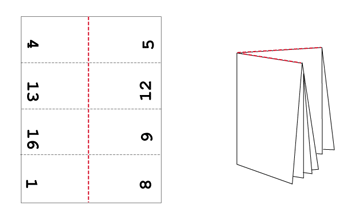One of the many frequently asked bindery questions I get is, “What kind of score should I use on a 16 page right angle signature?” It’s a popular format which folds once in the main section, once in the 8pp right angle, then once in the final 16pp right angle. (see diagram at right)
 My answer, which surprises many, is, “None.” You don’t need a score in there at all. In fact, adding a score to a 16 page signature can make you work harder than you should. I’ll give you the nuts and bolts answer here, and you can see it in more detailed action as we fold a 16 page signature in the video below.
My answer, which surprises many, is, “None.” You don’t need a score in there at all. In fact, adding a score to a 16 page signature can make you work harder than you should. I’ll give you the nuts and bolts answer here, and you can see it in more detailed action as we fold a 16 page signature in the video below.
It’s understandable why operators think they need a score. In 16 page signatures, at the last fold, we are folding four sheets. And we’re taught that any time we have two or more sheets in a right angle fold, we should score them.
The key to eliminating the score at the spine is to perforate along the head. The perforation allows air to escape during the final fold. From the paper’s point of view, it’s no different than having several parallel folds done to it in the first section. No score is needed as long as the fold imposition doesn’t trap any air.
So, forget the score. Instead, focus your attention on what’s happening in the first folding section. Make sure it’s folding accurately and consistently.Then select the right perf. You want as big a tooth on the perf as possible to allow maximum air to escape quickly, but not so big that the sheet falls apart. Once you find a good perf blade, you can probably use it for most of your 16 page signature work.
If the sheet starts to fall apart, or if you start to get wrinkles at the head, then you’ll need to try a different perf blade configuration. In this case we’re using an MBO 16 tooth perf, sort of a standard configuration for this type of signature work.
Lastly, of course, make sure you have good register with your perf. If it’s crooked, or bowed, or the sheet is bouncing around, you need to fix it before moving on to the second and third folds.
I’m a firm believer in using the 80-20 rule to make life easier. In this case, I’ve learned through experience that 80% of your signature folding problems will come from this first section. So if you’re diligent in setting it up, you’ll prevent most of the problems you might otherwise encounter. It wouldn’t hurt to run a handful of sheets at this point before getting to the right angles. If you see any variation, review your setup.
Once you’re happy with the first section, set your 8 page right angle fold to match the perf and then set your final fold. If the first section is set properly, you should rarely have to adjust the second two fold sections after your initial make-ready.
Removing the spine score decreases your setup time with no effect on quality. If you happen to be trimming the lip on your signature too, and you have a score on the 8 page section, then every time you make a change to the last fold you also have to adjust the score and the trim position. It quickly becomes tedious.
Simplify and get rid of the score. Of course there will be exceptions to any rule. Perhaps you have a 100# text with aqueous coating, folding against the grain that’s giving you fits. So yes, by all means if you need a score, use one. But try it first without one and use the score as a last resort.
Our short video below shows how easy it is to produce a high-quality signature with less work than you might have thought possible. As always, we welcome your comments, stories and suggestions below!

